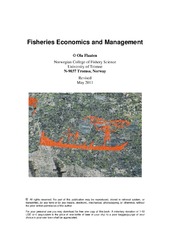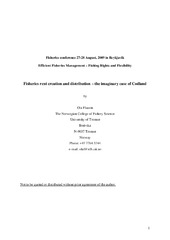Blar i tittel Artikler, rapporter og annet (Norges fiskerihøgskole)
Viser treff 344-363 av 930
-
FINNFJORD INDRE, 3`dje PRØVETAKING AV SEDIMENT VÅR og HØST 2017
(Research report; Forskningsrapport, 2018)Denne miljøundersøkelsen er den tredje etter at Miljødirektoratet i 2014 påla Finnfjord as å utarbeide et program for vannovervåking, og gjennomføre dette i vannforekomsten Finnfjord Indre. Første rapport ble sendt inn 29 februar 2016, og i en tilbakemelding fra Miljødirektoratet i brev datert 4 april 2016 ble det varslet om behov for en ny undersøkelse for å kartlegge omfang og spredning av ... -
First observation of seasonal variations in the meat and co-products of the snow crab (Chionoecetes opilio) in the Barents Sea
(Journal article; Tidsskriftartikkel; Peer reviewed, 2021-03-24)The snow crab (<i>Chionoecetes opilio</i>), SC, is a newly established species in the Barents Sea. The snow crab fishery has established itself as a new and profitable industry in Norway in the last decade. The fishery started as a year-round fishery, without any information of possible seasonal variations in the quality of the product. In 2017 a total allowable catch was established by the Norwegian ... -
First record of experimentally induced salmon gill poxvirus disease (SGPVD) in Atlantic salmon (Salmo salar L.)
(Journal article; Tidsskriftartikkel; Peer reviewed, 2020-05-07)Salmon gill poxvirus (SGPV) infection is a common denominator in many cases of complex gill disease in the Norwegian salmon farming industry and may, as a single agent infection, result in salmon poxvirus disease (SGPVD). Experiences from the field suggest that stress may be a decisive factor for the induction of SGPVD. Here we investigated the effect of stress hormone treatment on SGPV kinetics and ... -
First Steps Towards RAT: A Protocol for Documenting Data Use in the Agent-Based Modeling Process
(Chapter; Bokkapittel, 2021)While there is a number of frameworks and protocols in Agent-Based Modeling (ABM) that support the documentation of different aspects of a simulation study, it is surprising to find only a small number dealing with the handling of data. Here we present the results of discussions we had on the topic at the Lorentz Center workshop on Integrating Qualitative and Quantitative Evidence using Social ... -
Fish investigations in the Barents Sea winter 2017
(Research report; Forskningsrapport, 2017)Annual catch quotas and other regulations of the Barents Sea fisheries are set through negotiations between Norway and Russia. Assessment of the state of the stocks and quota advices are given by the International Council for the Exploration of the Sea (ICES). Their work is based on survey results and international landings statistics. The results from the demersal fish winter surveys in the ... -
Fish silage hydrolysates: Not only a feed nutrient, but also a useful feed additive
(Journal article; Tidsskriftartikkel; Peer reviewed, 2017-06-06)Background:<br> Processing of fish and shellfish may result in substantial amounts of by-products and unless they can be used as food, the most realistic option in most cases is the production of preserved feed nutrients. If large volumes are available, reduction to fishmeal and fish oil is the preferred technology. However, fresh by-products are most often available in insufficient quantities ... -
Fish Skin and Gill Mucus: A Source of Metabolites for Non-Invasive Health Monitoring and Research
(Journal article; Tidsskriftartikkel; Peer reviewed, 2021-12-31)Mucous membranes such as the gill and skin mucosa in fish protect them against a multitude of environmental factors. At the same time, changes in the molecular composition of mucus may provide valuable information about the interaction of the fish with their environment, as well as their health and welfare. In this study, the metabolite profiles of the plasma, skin and gill mucus of freshwater ... -
Fisheries economics and management
(Book; Bok, 2011-05) -
Fisheries Management and Global Warming. Effects of climate change on fisheries in the Arctic region of the Nordic countries.
(Research report; Forskningsrapport, 2014) -
Fisheries rent creation and distribution – the imaginary case of Codland
(Conference object; Konferansebidrag, 2009-08-27)This paper discusses actual and possible achievements and failures of Codland and examines it from the point of view of efficiency and in terms of distribution. It is argued in favour of the joint analysis of the two approaches when contemplating fisheries management reforms, since such reforms may create both winners and losers. The analysis demonstrates how rent drain from fishing communities and ... -
The Fisheries Sector in Ghana: A Political Economy Analysis
(Research report; Forskningsrapport, 2018-12-04)The fishery sector of Ghana is beset with problems, including widespread illegal, unreported and unregulated fishing.This report analyses the political economy of fisheries in Ghana, focusing on the power and interests of key actors in the sector and the constraints and opportunities faced by the government in addressing the existing challenges. There are three main challenges facing the sector. ... -
Fishes in a changing world: learning from the past to promote sustainability of fish populations
(Journal article; Tidsskriftartikkel; Peer reviewed, 2018-03-14)Populations of fishes provide valuable services for billions of people, but face diverse and interacting threats that jeopardize their sustainability. Human population growth and intensifying resource use for food, water, energy and goods are compromising fish populations through a variety of mechanisms, including overfishing, habitat degradation and declines in water quality. The important ... -
Fishing efficiency of biodegradable PBSAT gillnets and conventional nylon gillnets used in Norwegian cod (Gadus morhua) and saithe (Pollachius virens) fisheries
(Journal article; Tidsskriftartikkel; Peer reviewed, 2018-09-10)Fishing trials were carried out to compare the relative fishing efficiency of gillnets made of a new biodegradable resin (polybutylene succinate co-adipate-co-terephthalate, PBSAT) with conventional (nylon) nets. The fishing trials covered two consecutive fishing seasons (2016 and 2017) for cod (<i>Gadus morhua</i>) and saithe (<i>Pollachius virens</i>) in northern Norway. Results generally showed ... -
Fishing for mammals: Landscape‐level monitoring of terrestrial and semi‐aquatic communities using eDNA from riverine systems
(Journal article; Tidsskriftartikkel; Peer reviewed, 2020-03-10)1: Environmental DNA (eDNA) metabarcoding has revolutionized biomonitoring in both marine and freshwater ecosystems. However, for semi‐aquatic and terrestrial animals, the application of this technique remains relatively untested.<p> <p>2: We first assess the efficiency of eDNA metabarcoding in detecting semi‐aquatic and terrestrial mammals in natural lotic ecosystems in the UK by comparing ... -
Fiskeren fra veidemann til "advokat"
(Chapter; Bokkapittel, 2002) -
Fiskeridirektøren bør flyttes til Tromsø
(Journal article; Tidsskriftartikkel, 2016-11-17)Fiskeridirektøren og det tilknyttede reguleringsutvalget og forvaltningsorganene flyttes fra Bergen til Tromsø, i det minste den delen som angår forvaltningen av ressursene utenfor Nord Norge, foreslår artikkelforfatterne. -
Fiskeripolitikkens konsekvenser på kysten
(Chronicle; Kronikk, 2016-09-09) -
Flashing light emitting diodes (LEDs) induce proteins, polyunsaturated fatty acids and pigments in three microalgae
(Journal article; Tidsskriftartikkel; Peer reviewed, 2020-11-25)As the periodic emission of light pulses by light emitting diodes (LEDs) is known to stimulate growth or induce high value biocompounds in microalgae, this flashing light regime was tested on growth and biochemical composition of the microalgae <i>Nannochloropsis gaditana, Koliella antarctica</i> and <i>Tetraselmis chui</i>. At low flashing light frequencies (e.g., 5 and 50 Hz, Duty cycle = 0.05), ... -
Flashing lights affect the photophysiology and expression of carotenoid and lipid synthesis genes in Nannochloropsis gaditana
(Journal article; Tidsskriftartikkel; Peer reviewed, 2022-11-20)Nannochloropsis gaditana is a promising microalga for biotechnology. One of the strategies to stimulate its full potential in metabolite production is exposure to flashing lights. Here, we report how N. gaditana adapts to different flashing light regimes (5, 50, and 500 Hz) by changing its cellular physiology and the relative expression of genes related to critical cellular functions. We analyzed ... -
Flashing lights affect the photophysiology and expression of carotenoid and lipid synthesis genes in Nannochloropsis gaditana
(Journal article; Tidsskriftartikkel; Peer reviewed, 2022-11-20)Nannochloropsis gaditana is a promising microalga for biotechnology. One of the strategies to stimulate its full potential in metabolite production is exposure to flashing lights. Here, we report how N. gaditana adapts to different flashing light regimes (5, 50, and 500 Hz) by changing its cellular physiology and the relative expression of genes related to critical cellular functions. We analyzed ...


 English
English norsk
norsk


















